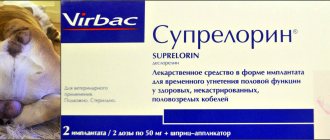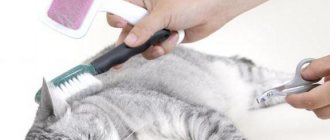Medical contraception
There are two methods of drug contraception:
Tablets and drops, such as the drugs “Sex Barrier”, “Conra-Sex”, “Cat Bayun”, etc., are the cheapest method of sterilization. However, their constant use often leads to the development of cancer, including tumors of the appendages, ovaries, and mammary glands.
Chemical castration of animals is also carried out in the form of injections, for which a drug such as Covinan is most often used, the effect of which lasts almost six months. This drug is used only in relation to cats.
Few people know that in Europe it is prohibited to give hormonal drugs to pets, and in some countries there is even criminal prosecution.
The main problem with the use of drugs is that receptors that perceive progesterone are located throughout the body, that is, a tumor can appear in any organ whose activity is regulated by hormones. And recent studies have shown that chemical compounds that suppress estrus and testicular function can cause the development of diabetes mellitus and worsen the functioning of the endocrine system. Side effects are quite difficult to predict, and pathologies will have to be treated throughout life.
One of the most terrible consequences of the use of hormonal drugs is pyometra - with this disease, the lining of the uterus thickens, in which bubbles and cysts appear, and subsequently pus forms. The disease itself can be noticed when the uterus is filled to capacity with pus - it becomes red and painful. At the same time, the animal barely moves, almost does not eat, and the body gradually begins to become intoxicated - the appetite worsens, the pet begins to feel thirsty, and drinks a lot. In this case, you can save the animal only by urgently removing the uterus.
This is interesting: How is endoscopic sterilization of cats performed?
If a cat marks after castration
global $ads_google; //data-ad-slot=”2475549904″ $ads_google = empty($ads_google) ? false : true; ?> if ($ads_google == false) {?>
$ads_google = true; ?> } ?>
This question arises periodically, and there is only one recommendation: find the reason for the tagging.
In the event of such an incident, the animal is brought for examination to a specialist, since the examination may reveal a poorly performed operation, or the cat turned out to be cryptorchid and its testicles are not in the abdominal cavity.
The solution to the problem may be a repeat operation - the testes need to be removed, as they produce sex hormones.
Another reason for leaving an unpleasant smell in the apartment from marks is the cat’s banal bad manners; here you will need to study tips on how to wean a cat from marking its territory.
There are animal psychologists who can help desperate owners cope with their cat’s desire to mark.
Pros and cons of chemical sterilization of cats
Undoubtedly, no matter which option you choose, each type of sterilization has its pros and cons.
Advantages of hormonal sterilization:
- No postoperative complications or rehabilitation period. There is no need to prepare the animal for surgery. No need to remove stitches. Postoperative risks (suppuration, infection of sutures) are completely eliminated.
- Simplicity of the procedure. If desired, having a veterinarian's prescription and knowing the dosage of medications, chemical sterilization can be carried out at home.
- Lack of response to anesthesia. Many cats, especially high-breed cats, are very sensitive to the effects of certain medications and are susceptible to allergies. Therefore, this technique is the only option that will prevent unwanted mating.
- Reversibility, normalization of reproductive functions. Chemical sterilization gives a temporary effect. The duration depends on the drug used. On average, the effect of injections lasts from 6-12 months to two years, after which a second injection is given. Tablet forms, drops or so-called contraceptives for animals give a shorter lasting effect (three to five months).
- Possibility of use if there are drug contraindications to surgery. This procedure can be performed in old age.
The advantage of this technique is the complete absence of injury, pain, and the cat does not require long-term rehabilitation.
Drugs that are used for chemical sterilization will also help in correcting the behavior of a mustachioed pet. There are hypersexual cats that during the rutting period become aggressive, uncontrollable, and run away from home. The drugs begin to act almost immediately after their use.
Preparing a cat for castration
Careful preparation of the animal is mandatory: the success of the operation largely depends on this. If you ignore the veterinarian’s instructions, you may experience health complications and, as a result, additional financial losses.
It is important to follow a strict diet, as anesthesia can cause a gag reflex. The male is not fed for 10-12 hours before the start of the procedure, which will prevent vomit from entering the respiratory tract. Water is not given 4-6 hours before surgery.
global $ads_google; //data-ad-slot=”2475549904″ $ads_google = empty($ads_google) ? false : true; ?> if ($ads_google == false) {?>
$ads_google = true; ?> } ?>
The cat should not have any diseases or health problems that could be a contraindication to castration.
A week before the operation, the cat is dewormed, and the day before it is washed with zoo shampoo.
Radiation sterilization
Chemical sterilization (castration) of male cats consists of irradiating the genital area with radioactive isotopes. The remaining parts of the body are covered with a special apron. The advantages of this method are:
- painlessness - outwardly has no effect on the body at all;
- many point to the relative harmlessness of the method, however, this is a controversial statement; however, when compared with other methods of sterilization, irradiation is indeed relatively safe.
This procedure is expensive and there is very little equipment for it in our country.
Implant method of sterilization
The most gentle method, along with irradiation, is the implantation of a chip, which is implanted under the code on the withers and gradually dissolves over time. Such a chip itself is a small cylinder, the size and color of a grain of rice, and is loaded into a special syringe. This drug does not work immediately, only after six months and continues to work for almost 1.5 years. Any mating within six months after insertion will result in pregnancy.
After the chip is removed, sexual function is restored within three months. The drug itself bears the trade name “Suprelorin”; it has proven itself well for castration of cats and sterilization of cats. The implantation of the chip is almost painless . The dosage of the drug is different, which affects its cost. When purchasing a chip, you need to pay attention to the availability of certificates.
Side effects of the drug include swelling at the implantation site, as well as collagen accumulation and shrinkage of the testes in cats. In rare cases, the testicle may become slightly swollen.
This method of chemical castration of cats or sterilization of cats should be used specifically on an adult animal, since studies on adolescents have not been conducted previously.
It is up to the owner to decide whether to chemically sterilize (castrate) the cat or not, however, if the pet’s condition does not contraindicate surgical intervention and the animal’s future reproduction will be undesirable, it is best to carry out the operation.
Where is it better to castrate a cat: at home or in a clinic?
Castration of a cat can be carried out both in the clinic and at home. The doctor’s algorithm of actions and the requirements for conditions remain the same. Both options have advantages and disadvantages.
Place of castration
pros
Minuses
At home
- no stress from an unfamiliar room
- no need for transportation
- minimal risk of getting an infection
- material savings
- the owner must be nearby (you will need to take days off)
- impossibility of providing emergency assistance if the animal becomes ill
In the clinic
- You can leave the cat under the supervision of doctors until complete recovery
- comprehensive medical care for your pet
- providing urgent care for complications
- stress for the cat
- there is a possibility of contracting an infectious disease
- higher service price
Chip sterilization
- Refers to gentle types of chemical sterilization. A chip is implanted under the skin in the withers area. Over time it dissolves. A chip is defined as a “grain” the size of rice. It is loaded into a veterinary pistol and then injected under pressure under the skin.
- The substances in the chip do not immediately begin to act, but after about 5-6 months. Then the chip works for another 1.5 years. If a female mates with a male within six months after chipping, fertilization will occur. Therefore, you need to keep an eye on the cat.
- If the chip is removed, its effect will cease after 3 months. Therefore, the procedure can be called reversible. The ability to procreate will be restored. Animals are microchipped with the drug “Suprelorin”. The amount of the administered substance is determined by the doctor.
This is interesting: Life expectancy of a cat after sterilization
Suprelorin
It is used for temporary sterilization of cats when mating is not recommended for a certain period of time and the owners do not want to castrate the animal surgically. Suprelorin is an implant that dissolves under the skin over a long period of time.
Compound:
The active ingredient is deslorelin acetate.
Additional components:
- Palm oil;
- lecithin;
- sodium acetate.
The substance appears as a white or pale yellow cylinder.
Usage
The drug is injected subcutaneously into the withers. The dosage depends on the weight of the cat, you should consult your veterinarian. In long-haired breeds, the hair is cut at the injection site. Follow aseptic and antiseptic measures.
The implant cannot be inserted into the subcutaneous fatty tissue, as fat inhibits the absorption of the active substance. Introduction procedure:
- Insert the needle.
- Press out the implant.
- Press down on the skin and remove the needle.
- Continue applying pressure to the skin for half a minute.
- Feel the implant to make sure it is under the skin.
Action
Suppresses the functioning of the pituitary gland, which leads to the cessation of the production of follicle-stimulating and luteinizing hormone. And this in turn leads to a stop in spermatogenesis and a drop in testosterone levels in the blood. Deslorelin reaches its peak concentration in the period from 7 to 35 days, while infertility is achieved 6 weeks after implantation and lasts for 6 months.
Other instructions
If the dosage is exceeded, no adverse reactions are observed. Exceeding the dose leads to an increase in the period of restoration of sexual functions to 12, and in some cases – up to 18 months. However, exceeding the dosage is not recommended, since there have been insufficient studies, libido suppression and sexual dysfunction are possible.
The desire of cats to reproduce is quite natural - this is their natural instinct, which can be dealt with surgically. However, not all owners choose to sterilize their pets, despite the inconvenience experienced by the cat and the owner himself during the period of estrus. We are afraid to give the animal to a veterinarian because they do not know that sterilization of cats without surgery and without incisions has long existed.
Caring for a cat after castration
How long does it take for a cat to recover from anesthesia? Depends on what kind of drug was used. In any case, you need to monitor the cat’s behavior after castration : the animal will experience stress, so you will definitely need to show it affection and attention. A cat who is restless after neutering will feel more confident if the owner holds him on his lap, pets him and talks to him.
After the anesthesia wears off, the cat can sleep for several hours. The awakened animal is usually weakened and disoriented. If a cat shows aggression against this background, then it is quite capable of causing injury to itself and its owner. It is important to be nearby at this moment and calm the pet. This behavior may be associated with dizziness and nausea.
Anesthesia has a depressing effect on thermoregulation processes in the body, so the operated cat is placed in a warm place away from drafts.
Immediately after the pet gets up, it will rush to look for water, so the bowl with it should stand next to the rookery.
The toilet should be within the animal's access area after anesthesia.
If during the operation the cat was not given saline solution or an “artificial tear” drug, then dryness on the cornea will be eliminated by lacrimation.
The wound will need to be treated: if dirt appears, they are removed with a damp cotton pad and treated with an antiseptic. It would be better to put an Elizabethan collar on the cat's neck - it will not allow the animal to damage the seams. After 4-5 days the device is no longer required.
In just a few days the cat will return to normal and recover.
Feeding castrated cats
After castration, very little time should pass, the pet’s body will be rebuilt, and the character of the furry friend will become softer. He will be less and less drawn to street walks, but his appetite may increase noticeably.
To prevent a once powerful healthy cat from turning into a fluffy dumpling of particularly large sizes, it will be necessary to reduce the total calorie intake by 25-30%.
Food for neutered cats does not include fish dishes, and it is better to avoid dry non-specialized food altogether. Fried, salty, fatty foods are not recommended.
An excellent healthy food would be porridge and boiled lean meat. There is a ready-made balanced food for neutered cats.











